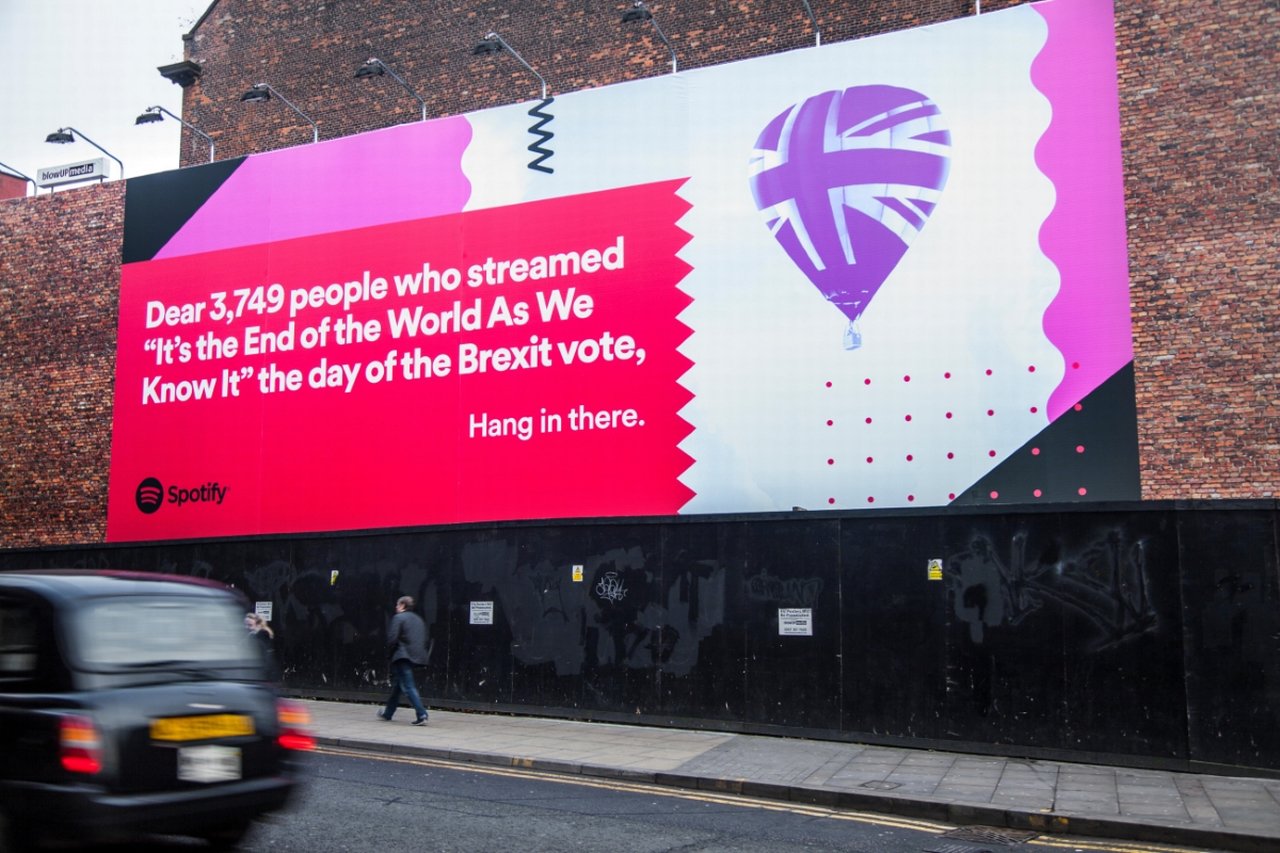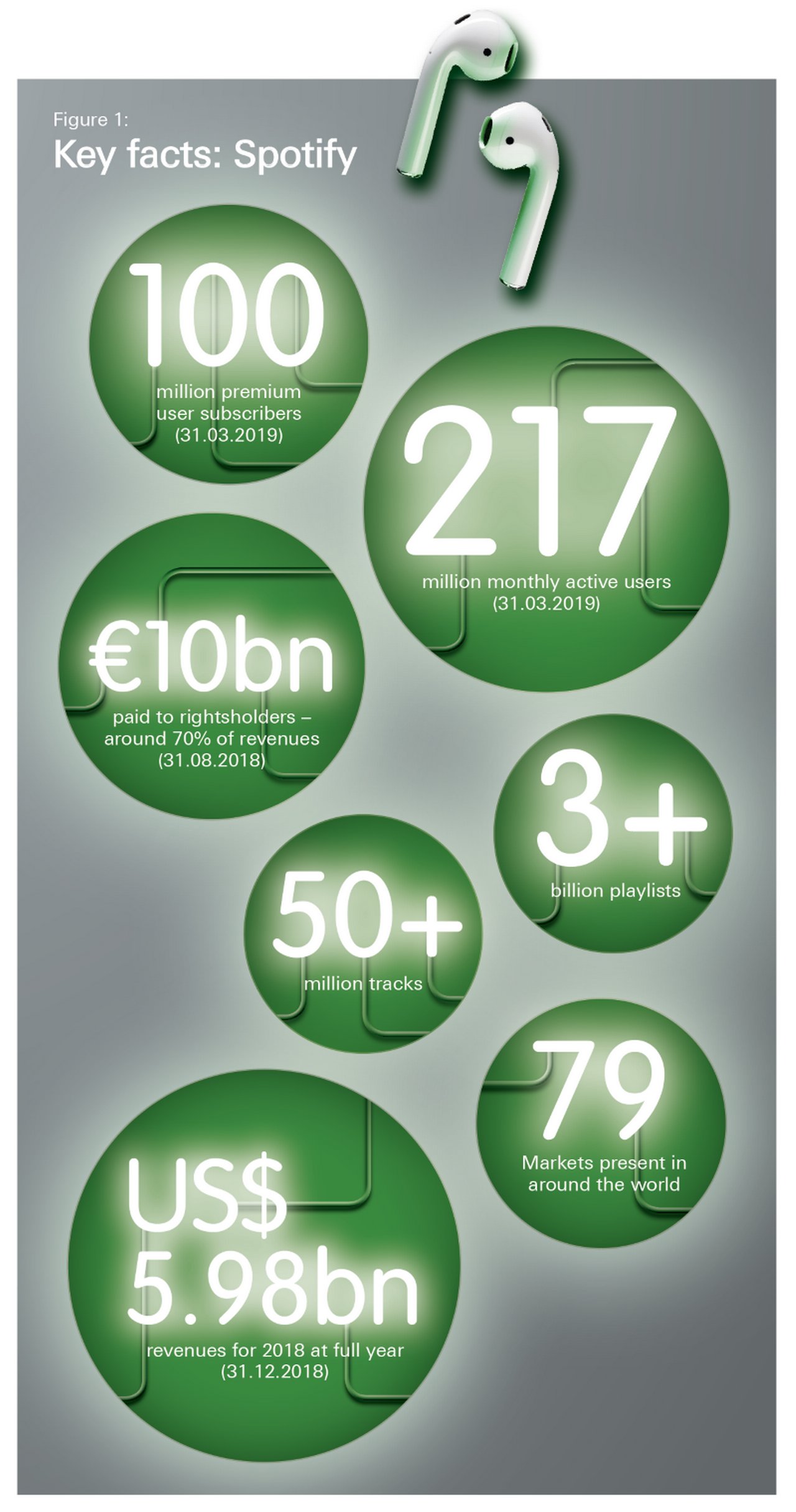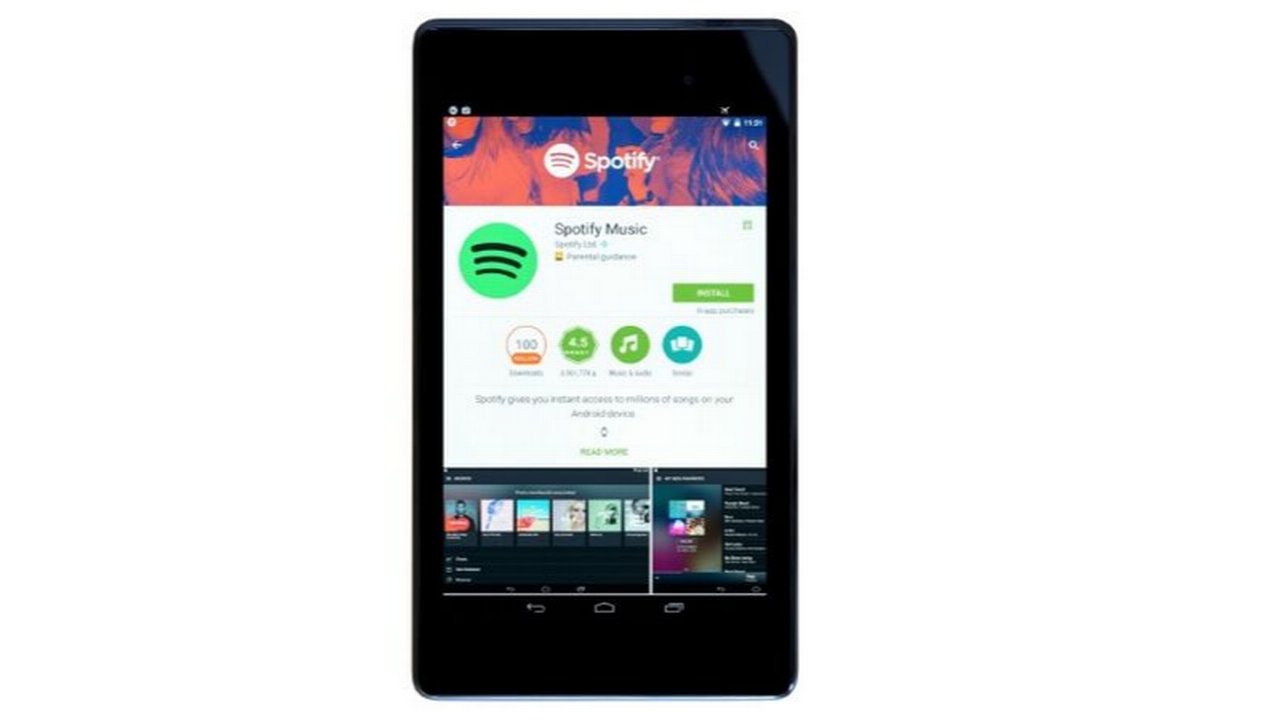September 2019
Until Spotify disrupted the music ownership model, the music industry was under siege from piracy. Now revenues are growing again, and the landscape has changed for both artists and fans. Clarissa Dann reports on how the Swedish audio media phenomenon has applied its corporate treasury infrastructure to support this incredible growth story
“For a start, you can throw out all those CDs that are taking up that shelf space,” said Daughter Number Two. “Nobody listens to music that way anymore.” She then proceeded to download an app onto my phone in the form of a green blob with soundwaves, and quickly demonstrated with carefully chosen samples that my entire music collection – from David Bowie, Pink Floyd and Dido through to the complete set of the Monteverdi Choir’s Bach Cantatas (in church year order) – could be Bluetoothed across from my iPhone to a portable speaker.
In fact, it was annoyingly easy to get going, and I have never looked back. Nor, it would appear, have 100 million other paid subscribers of this Swedish audio streaming platform that provides digital rights management-protected music and podcasts from record labels and media companies where almost 70% of revenues are paid back to the music industry in royalties.
The Spotify story was one of the main points on the agenda at a recent Global Treasury Leaders Summit staged by The Economist Events; part of a treasury engagement programme supported by Deutsche Bank that won a World Media Award. Presenting at the event, Spotify’s new Treasurer, Patrik Hallerström, shared with delegates how enabling innovation and adapting technology in small steps supported Spotify’s rapid growth from its formation in 2006 through to its listing on the NYSE in April 2018, and onwards to the €5.98bn revenues reported for 2018. Before he joined Spotify, Hallerström had spent 15 years in various positions in treasury departments in the manufacturing and telecoms industry. It was the perfect preparation for navigating this particular industry disrupter.
Pirates of the airwaves
There is a lot of focus on how we should invest cash in the right way to continue our growth
During a 15-year period from 1999 to 2014, music industry revenues declined by 40%, with piracy being the main culprit. The all-time revenue high of US$27bn within the worldwide music industry in 1999 had almost halved by 2008, despite a range of efforts to tackle the problem. Sweden, noted The Guardian in 2013,1 “had the worst piracy in the western world”, and record labels were laying off staff. The ownership model, explained Hallerström, was broken and artists were suffering.
In 2006, Swedish entrepreneurs Daniel Ek and Martin Lorentzon deployed their knowledge of technology and their passion for music to find a solution. The mission was to help change the way people enjoy and discover music via a method that did not involve piracy and downloading. As Ek put it in an interview with The Guardian: “People were listening to more music than ever in history, and yet the music industry was doing worse and worse. So the demand for content was there, but it was a different business model.”
US$7.4bn
Enter streaming. Record labels were approached with content rental propositions, engineers were hired to develop the optimum technology and Spotify (literally ‘spot’ and ‘identify’) was built on a core set of values that underpin it today: innovation, passion, collaboration, transparency and fairness. “It’s part of Swedish culture and it’s how we work together, how we treat our users, and how we want to be seen in the community,” said Hallerström. Spotify streams audio experiences (music and podcasts) on different platforms and wants to be wherever the users are – tablets, smartphones and laptops.
Launched originally as desktop-only in the Nordics, France and Spain in 2008, the service reached the UK in 2009 where it started to gain momentum with paid subscribers, then continued in 2010 to the Netherlands and then on to the US which, said Hallerström, “was and continues to be a critical market for us”. The service reached Australia in 2013 and global adoption continues apace, while all the time work continues in getting the music industry to understand that streaming and digital delivery is the future.
By March 2019, Spotify reported an unassailable 217 million monthly active users, 100 million of which were paid up subscribers (see Figure 1). In its 2018 annual report, the Recording Industry Association of America (RIAA) noted that in the US, “Revenues from streaming music platforms grew 30% year-over-year to reach US$7.4bn, contributing 75% of total revenues for 2018, and accounting for virtually all the revenue growth for the year.”2 In other words, streaming has reinvigorated industry revenue growth and afforded artists a channel through which they can distribute and amplify their work in the most efficient way possible.

A Spotify banner in Manchester, UK
Scale and flexibility
“What makes us successful is our ‘freemium’ business model,” explained Hallerström. “It provides us scale and flexibility and reduces friction. It is actually very hard to monetise a free business model, but it’s also hard to scale up a paid-only model. So freemium works for us – around 50% of free users become subscribers over time.”
These stats resonate as, having personally experienced both the free and paid options, I could not imagine going back to random advertisements and shuffled tunes. It took the company eight years to reach 10 million paid subscribers, but then customer acquisition accelerated and the last 10 million arrived in just four months in the period leading up to March 2019. “There are around 1.3 billion payment-enabled smartphones and only 12% of those are streaming music. We service half of those. We see the addressable market growing to around three billion and we will leverage our freemium model,” Hallerström declared. He continued, “It costs less to acquire subscribers and the lifetime value of being on the platform and getting engagement makes it sensible for us to keep growing and increase the enterprise value of the firm.”
The company works just as hard to attract and retain artists. “We don’t just want to be relevant for our users, but also for our artists,” noted Hallerström. A Spotify artist receives advice and support on how to be more informed about distribution and marketing using the data insights on tracks played. He told the story about a US band that had no idea they were popular in Argentina, but the data pointed to a following there. A tour was booked that was phenomenally successful. “You see other bands changing their set lists on gigs when they see the data, depending on the most popular songs in that country,” he added.
Growth comes before profit right now for Spotify because this increases the enterprise value. A glance at the 2018 full-year accounts reveals an operating loss of US$43m – an improvement on the US$378m loss for 2017. “If we stop growing we will become profitable, but it’s about being the largest in the industry. We have a positive free cash flow and there is a lot of focus on how we should invest the cash in the right way to continue our growth,” said Hallerström.

Operational support
Such rapid expansion demands a lot from support functions around the organisation, and corporate treasury is the lynchpin. Until 2013 there was no dedicated treasury and Hallerström’s predecessor, Johan Bergqvist – who joined in 2013 – not only managed obvious treasury functions but also investor relations, corporate finance and the management of the share register. “As we grew we put the payment infrastructures in place and focused on how to manage FX risk and positive cash flows from investments,” reflected Hallerström, who had worked closely with Bergqvist from the beginning.
In that time, the treasury function itself has evolved to eight people (seven in Stockholm and one in New York), and the complexities of a business model comprising cash coming in from millions of monthly subscribers in 35 different currencies called for a robust infrastructure that could cope with it all.
"Our mission
Unlock the potential of human creativity by giving a million creative artists the opportunity to live off their art and billions of fans the opportunity to enjoy and be inspired by these creators "
Treasury hub
In 2014, the treasury team turned to the Kyriba treasury management system (TMS) to create a “solution-orientated and agile treasury to support short and long-term business expansion”.
According to Kyriba,3 the initial stages of the implementation focused on building the bank reporting architecture via Kyriba’s integrated SWIFT Service Bureau, structuring the Spotify entities to align with the cash pools set up within the enterprise. The TMS provider continues, “A payment import from and general ledger export to the main enterprise resource planning (ERP) solution were set up, as well as a market data feed and online trading platform interface.” Legacy spreadsheet-based cash positioning feeds were reconciled to the new process. Segregation of duties built into the approval workflows were shared between the treasury team and accounting department centrally within Kyriba. This provided visibility and security of payments, while reducing reliance on bank-specific software. The last part of this first stage was the prior day reconciliation workflow with cash categorisation and transaction matching, allowing Spotify to post general ledger journals for all bank activity to the ERP system on a daily basis.
All global payments are run from Kyriba, and its implementation as a payments system into the ERP system itself provides valuable insights on data about group payments – and makes it easier to navigate Sarbanes-Oxley Act (SOX) compliance now that Spotify is listed on the NYSE. SOX is the US regulation in place to protect shareholders and the general public from accounting errors and fraudulent practices.
Enfolding all of this are the Spotify corporate treasury guiding principles. “How do we work?” asked Hallerström. The answer is to “think ahead and not get stuck in the process that works today”. This means working with banks and service providers in order “to get where we want to be tomorrow”. Collaboration, he emphasised, is key both internally and externally with Spotify partners. And all the time, the focus is on scalable processes and technology – Spotify is not encumbered with legacy systems and started with a pretty clean slate. “When we look back, we have not had a huge project that consumed resources – we kept the steps small and learned on the way, rather than a big bang approach.”
Cash collection and reporting
Although centralised in Stockholm (the majority of the subscription-based flows, with the exception of the US market, go into one entity), treasury is in different markets that require a distinct local presence or activity and a separate strategy for extracting revenues. “We can do this from a centralised treasury while acting local,” added Hallerström.
The majority of cash flows come from Europe and North America courtesy of paid subscribers, with the US representing the largest market for the group. But, said Hallerström, “Latin America is doing really well and we have gained traction in Mexico and Brazil. The expansion drives investment in infrastructure and we need to ensure we have scalable processes in the organisation and in treasury.”
Before Spotify enters a new market, the team do their homework well in advance, as challenges and set-up vary from market to market. “The Nordics and the UK have a lot of paying subscribers compared with free users, and in Spain and Italy the reverse happens and a lot of work goes into converting free to paid. When we enter India and other emerging markets, we have to think different, as users in those markets are not accustomed to paying for streaming music.”
The freemium business model requires intuitive financial systems to ensure that non-paying active users remain separated from premium paid users, and that assumptions for forecasting on conversions from free to paid are accurate. In addition, with new users joining each month, accounting systems have to deal with the fact that a proportion of each subscription falls into the next financial year.

Robotic process automation
Another area of development is on the currency risk segment. Spotify did no FX hedging before 2016, and given that it collects revenues in 35 different currencies there is a significant FX exposure to manage. Hallerström said that the company has now implemented a hedging programme, automated it and added robotics.
Spotify values: innovation, passion, collaboration, transparency and fairness
This, he added, “is not about taking work away from people, but more allowing the robot to do repetitive work, so that we can take informed decisions and work on other tasks.” The treasury team started small by taking low-hanging fruit and using robotic process automation (RPA) to transform six different financial processes. Getting it all to work means being sensitive to where other stakeholders in the finance team are on the journey. “If the robot breaks, we need people to understand the process and what to do. Careful use of RPA is about working out what is right for your business and trusting your gut instinct,” reflected Hallerström.

The group is continuing to find new ways to innovate and is one of the 28 supporters of Facebook’s new cryptocurrency project, Libra. Others include Uber, Mastercard and Vodafone.
The exciting journey continues.
Sources
1 See https://bit.ly/2XSpo0F at theguardian.com
2 See https://bit.ly/2TitLf1 at riaa.com
3 See https://bit.ly/32sMbzI at kyriba.com
Go to Corporate Bank EXPLORE MORE
Find out more about products and services
Go to Corporate Bank Go to Corporate BankStay up-to-date with
Sign-up flow newsbites
Choose your preferred banking topics and we will send you updated emails based on your selection
Sign-up Sign-upSubscribe Subscribe to our magazine
flow magazine is published annually and can be read online and delivered to your door in print
You might be interested in
CASH MANAGEMENT {icon-book}
March to change March to change
Clarissa Dann meets Group Treasurer Soumyo Dutta at the Reliance Industries Mumbai headquarters to discover more about its rapid organic growth, its journey to debt-free status, and how its treasury has aligned along the way
NEWS, CASH MANAGEMENT
Supporting corporate treasurers working from home Supporting corporate treasurers working from home
Deutsche Bank’s FX platform capabilities are helping corporates facing exceptional challenges triggered by the global pandemic – from maintaining liquidity to enabling employees to work from home
CASH MANAGEMENT
Basel yesterday, today and tomorrow Basel yesterday, today and tomorrow
Prudential regulation in the form of the Basel accords on capital adequacy has been evolving for almost 30 years. Etay Katz and Kirsty Taylor explain this quest for safety and soundness as “Basel IV” awaits agreement



